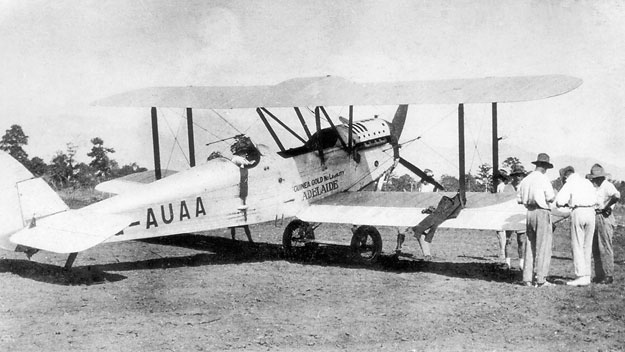
Following
use from new by the CAB since 1924, De Havilland
DH37 G-AUAA (c/n 105) was sold to Salamaua Development Co Pty Ltd in late 1926
for £2,000, who in turn sold it to Guinea Gold (No Liability), Adelaide
SA, on 13 Jan 1927 for £2,500, plus 500 paid-up Guinea Gold shares. Click
here to read more about its earlier history.
G-AUAA was test-flown at Essendon by E.A. ‘Pard’ Mustar (who had previously been instructing at the Aero Club, Essendon), before being shipped to Lae on the S.S. Melusia, arriving at Rabaul on 1 February 1927.
The
force behind Guinea Gold (No Liability) was Cecil John Levien, a former District
Officer. Whilst G-AUAA was on its way to Rabaul, ex-AFC Pilot Clarke, from
Rabaul, visited and recommended the landing sites for Lae & Wau, which C.J.
Levien immediately had cleared for Guinea Gold.
After arrival at Rabaul, G-AUAA was fitted with an extra fuel tank, which enabled pilot ‘Pard’ Mustar to fly it to Lae on 31 March 1927 (some 720km, mostly over open sea). On 19 April, it became the first aircraft to land at Wau, the aerodrome for the goldfields (flown by ‘Pard’ Mustar, with a miner, named Taylor, as a passenger, probably to help him find Wau - it was Mustar’s 4th attempt to locate Wau and the flight took 45 minutes).
Although the DH37 could carry only 270kg of freight, in its first 6 months of operation it carried some 8,000 lbs (3,620kg) of freight and 150 passengers. It reduced the round-trip time from 18 days by land to just 75 minutes.
Later in 1927 a proposal was made for the formation of a new company since Guinea Gold (No Liability) was not a common carrier and thus could not carry passengers or freight for others. The resulting company, Guinea Airways Ltd, was registered in Adelaide in November 1927 with a nominal capital of £50,000, of which £20,000 was initially subscribed. G-AUAA was the aircraft initially used. It's registration marks were later changed to VH-UAA in accordance with the general changeover in registrations.
On 22 April 1929 VH-UAA was sold to F N Drayton and J P Hammond in partly re-built state. By November 1929 it had changed hands again to an owner in Sydney. The aircraft passed through two more owners including, briefly, well-known pioneer flyer F T 'Tommy' O'Dea before it was damaged beyond repair in a landing in the sea off Crowdy Head, east of Taree NSW, on 25 March 1932 and was struck off the Register on 7 April 1932.
Tim Smith, Maritime Archaeologist and Movable Heritage Officer with the NSW Heritage Office reports*: "A rare aircraft type crashed into the sea at Crowdy Head on 25 March 1932. Piloted by Pat Hall with Harry Purvis and John Kingsford Smith aboard (nephew of Sir Charles Kingsford Smith), the plane clipped a wave. The trio had been flying from Sydney to Port Macquarie to earn some money running Easter weekend joy flights and 'barnstorming'. The crash occurred about one kilometer out in the middle of Crowdy Bay and the crew made it ashore after a long swim."
The date and place of the photograph above are not known, however it was certainly taken c. 1927-1929. The aircraft was doped silver overall and the writing on the side of the aircraft reads "GUINEA GOLD No Liability / ADELAIDE". Note that part of the upper fuselage decking around the front cockpit has been removed.
Click here to read more of the history of Guinea Airways.
*
Plane Sailing The archaeology of aircraft losses over water in New South Wales,
Australia.
(Photo:
CAHS/Len Dobbin collection)
Back
to Departmental Aircraft index page
Back to the main Items of General Interest index
If
this page appears without menu bars at top and left, click
here